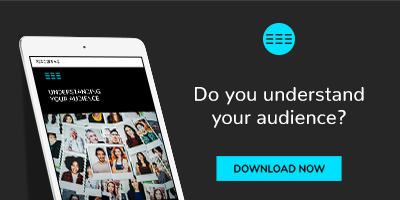When it comes to building superior customer experiences, the better you know and understand your customer, the better and more tailored an experience you can offer. While having a good grasp of your key customer demographics, such as age, gender, income, region and so forth, is a good first step, offering truly tailored solutions requires a much deeper understanding of how your customers think, feel and behave.
Which is where customer segmentation comes in.

Related content: Understanding Your Audience [Free Online Guide]
Customer data: the backbone of your segmentation
Customer data provides an excellent starting place for building customer segments, especially if you have a loyalty programme. With a well-organised database, you can group your customers according to their lifetime value, how frequently they spend, how much they spend per shop, the products they buy, how they respond to your marketing messages and more.
“What’s incredibly powerful about this kind of segmentation is it draws on actual, observable behaviour,” says Perceptive General Manager, Oliver Allen. “The evidence is right there in the data and it’s precise.”
Running RFM (recency, frequency, monetary) modelling on your customer database is also an excellent way to segment your customers according to their potential value to your business. From this, you can tailor your marketing and offerings to better engage with your most valuable segments.
Read more: The power of claimed behaviour versus actual behaviour
The weakness of this kind of data is it can often lack context—why they bought this product and not that one. Why they clicked on a particular offer in a marketing email. Why they drop in twice a week while others might only come by once a month. To better understand the mindset of your customers and what drives them to purchase (or not), a different approach is needed.
Delve into emotional drivers
These are the emotions that drive people to purchase your offering(s). From something as simple as “it makes me feel good” for a cup of coffee to “it makes me feel powerful” for a sports car, uncovering and understanding what motivates your customers requires in-depth qualitative research, either through one-to-one interviews or focus groups.
From there it’s a matter of segmenting your customers according to their drivers, be they bargain hunters, luxury seekers, convenience shoppers and more. Having these segments will allow you to personalise your marketing and offerings, from the tone and language you use to the sales and offerings you serve up to certain segments and even how you package your offering to appeal to different buyer motivations.
“Understanding what aspects of your offering appeals the most to certain groups of consumers is powerful information. With it, brands can construct their products, messaging, and marketing creative to meet and speak to consumers’ needs and aspirations, creating more effective marketing and sales, and ultimately better ROI,” says Oliver.
Go beyond your industry
While customer data provides behaviour insights and qualitative research sheds light on your customers’ emotional drivers, they do not always provide a full picture of a customer’s context. This can include their socioeconomic status, whether they have dependents, social causes, hobbies or even other brands they buy/engage with.
For example, say you’re a grocery market and have a segment of customers who shops frequently with you but only spend small amounts. You’ve also recently learned they are driven by a bargain-hunting mindset. Despite having these insights, it’s still not always clear why this group of customers are behaving this way. Are they students who live paycheck to paycheck? Pensioners who have been squeezed by the sudden rise in the cost of living? Perhaps they are working professionals who swing by your market on the way home to pick up dinner on the days they work in the office.
“It’s easy to overlook the importance of understanding customers holistically,” says Oliver. “Getting the full picture can give brands more ways to engage their customers, from causes both you and your customers can unite behind to communicating the values both your brand and your various segments have in common.”
Listen to individual experiences
There’s no mistaking that having an in-depth understanding of your different customer types and the commonalities they share is a major asset in a business’s ability to connect with customers. However, if you want to truly build personalised one-to-one experiences, you need to listen to your customers on a one-to-one level as well. One of the best ways to do this is with a Voice of Customer programme that collects customer feedback using the Net Promoter Score (NPS).
While NPS produces an overall customer experience score (between -100 and +100), it also produces three customer segments according to the out-of-10 score customers give your business. These are:
- Promoters (those who scored you a 9 or 10 out of 10)
- Passives (those who scored you between 5 and 8 out of 10), and
- Detractors (those who scored between 1 and 3 out of 10).
The NPS survey also frequently asks customers to explain why they gave the score they did. This information is particularly valuable as it allows you to pinpoint points specific strengths and weaknesses in your business. With these insights, you can improve individual moments in your customer journey and further refine and personalise according to your feedback.
“A Voice of Customer programme is a powerful way to make customers feel heard,” says Damian Bennet, Senior Business Director at Perceptive. “Responding to customer feedback in a meaningful way shows customers you care about them and are willing to listen, grow and evolve to meet their changing needs.”
In short, it’s the kind of segmentation that builds bridges. Listening makes brands feel personal, which builds trust, loyalty and long-term relationships that keep customers coming back time and time again.
Learn more about the power of segmentation and how it can enhance your marketing and cut-through with our all-in-one guide: Understanding Your Audience.
